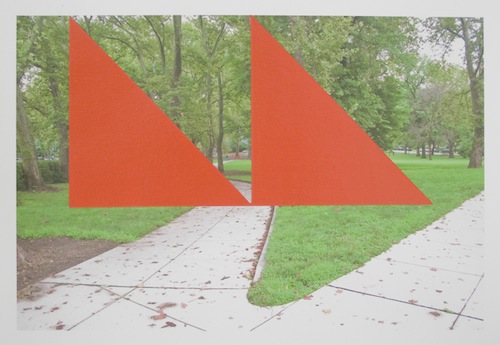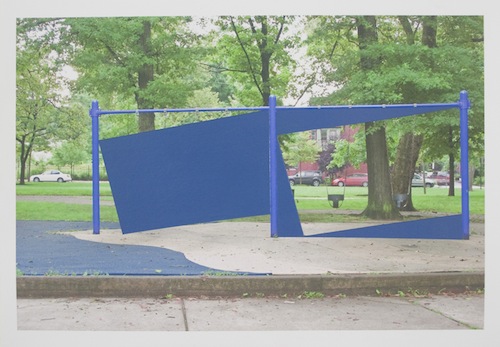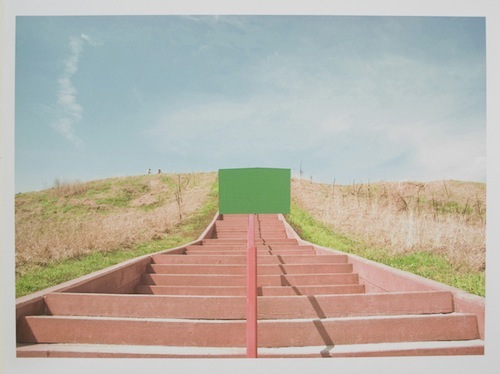 Up the Plateau, Green, 2013, Acrylic on archival inkjet print 8.5 x 11 inches
Up the Plateau, Green, 2013, Acrylic on archival inkjet print 8.5 x 11 inches
Todd Keyser’s painted interventions subject the photograph to a kind of scrutiny that works on it in several contradictory ways. On one level the addition of flat abstract shapes act like a breakdown or a collapse within the photographic model of representation. The photograph becomes a starting point for painting that is very different from the traditional space of the blank white canvas. Keyser’s colorful geometric patterns seem to expose the underlying compositional structure of the photograph, as though there is a gap or absence. This is not the only way to read them.
After spending some time with the work I noticed that by subjecting the image to the additive process of painting Keyser allows something else to happen. The content of the image becomes elusive, the hard- edged shapes, frame, crop, and confuse figure/ground relationships. Gestalt, a perception of the picture as a whole, is reinforced through repetition. What is striking, though, is that, rather than seeking to resolve themselves, Keyser’s compositional solutions are provisional. Each option seems an equal and acceptable solution to the other. The work opens up questions about the continuation of the act of picture making and makes a strong case for slowing down and examining what is presented. Through an e-mail exchange we have discussed some of the key concerns in the artists work.
Centered Triangles, 2013, Acrylic on archival inkjet print, 8.5 x 11 inches
Bart: What is happening to painting as is interacts with complex modes of digital image distribution?
Todd: I think what painting does with digital images is that it slows them down. I think the medium of painting is quite good at slowing us all down and asking us to have another look. In someway I see this as very much in opposition to the way culture quickly moves though images and information in general. Painting can get in the way of this and slow it down and that appeals to me very much. It’s archaic past and quality may just be one of its best attributes.
Swing set, 2013, Acrylic on archival inkjet print, 8.5 x 11 inches
Bart: This is something that you are getting at and how can painters extend painterly concerns into new media?
Todd: The main thing here is to ask yourself: what is the nature of one medium to another? For example: what makes a painting a painting? You go through these questions in your mind as your reflecting on what you’ve just made. One has to ask themselves: what do you allow yourself to do and why are you doing it? So for me in this case, I was painting my way through these various images that I was photographing myself – this felt more appealing to me instead of ripping the images from internet – the process of constructing these overpainted photos became more compelling and time consuming. And by bringing painting into photography the paint can then act as an intervening agent, followed by the reflexive observation: the space and materiality in the digital photo gets altered profoundly. Strategically, the paint is used in a limited way by painting in one basic shape onto the photograph and that painted intervention then has to be dealt with by the beholder. The results of these works reminded me of the theatricality of minimalist sculpture or painting. I find that rather interesting.

Mound in the Landscape, 2013, Acrylic on archival inkjet print, 8.5 x 22 inches
Bart: What you are doing involves an element of digital sampling but it does not feel like straight Postmodernist appropriation.
Todd: One aspect of what makes these works feel a little less appropriated is that I think the images feel chosen rather than quoted. Like there is a purpose behind all of this. The way I go about choosing the image is that I walk around the park and other areas in my neighborhood in West Philly and respond to real places that can either become a stage for these painted shapes and or have the shapes interrupt the artifice that I’m locked into, like a perfectly manicured lawn, a well kept park etc. Or just something that denotes naturalization. I feel that when I take the photograph myself rather than rip it from the internet there is a complexity and a richer dialogue that happens as a result of this. I therefore claim authorship for these choices rather than having it created for me by someone else’s decisions. This is something that happened over the course of a few months (February – August 2013). If I’m appropriating anything it could be the painted geometric shapes. But even then, I try to be sensitive to how I use them and this sensitivity I believe undercuts the function of quotation in the postmodern sense. So these do somehow, as you say, resurrect some attributes of the earlier modernist ideas like alienation effect and making strange and the later ideas of objecthood.
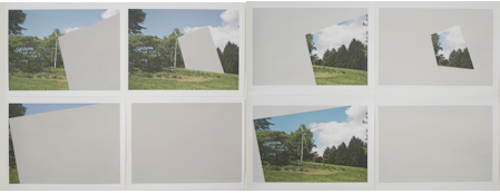 Grey Paintings 1 & 2, Morris Arboretum, 2013, Acrylic on archival inkjet print, 17 x 44 inches
Grey Paintings 1 & 2, Morris Arboretum, 2013, Acrylic on archival inkjet print, 17 x 44 inches
Bart: Your work seems like a continuation of late modern and minimalist concerns and extends them in a meaningful way. Like you said, you are “claiming authorship.”
Todd: Yes, I think so – this whole business of making myself go out to create the images from scratch in order to stage them and to then make the artifice of the landscape strange through the injection of geometric shapes of paint is modernist to its core. The weird thing about this though, is how that by combining of these two mediums (photography and painting) together leads to the rise of a third position or thesis in the work which ambiguously occupies the practice as a sculptural one. This third proposition forces the beholder to have to try to figure out what exactly is going on. There is a question of medium specificity here that keeps this project unfolding in really interesting and unpredictable ways. I feel endlessly engaged in this. I really do enjoy just walking around anywhere shooting photographs and then taking them to the studio, painting on top of them in various ways and then speculating about the results and what to do next.
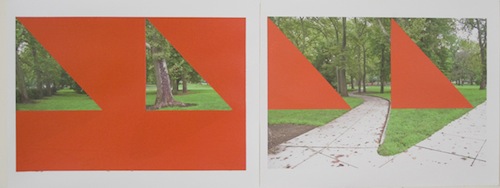
Triangles in the Park, 2013, Acrylic on inkjet print, 8.5 x 22 inches
Author Bart O’Reilly is a multi-media artist and adjunct professor at Harford Community College. He has shown work in Ireland and the United States and writes about art and critical theory.
Artist Todd Keyser is a painter who lives and works in Philadelphia, where he is the Assistant Director at Gross McCleaf Gallery. His works are currently on exhibit at A City(ies) that Walked, The Archigram Space Program, curated by Cooper Holoweski and Rubens Ghenov at Tiger Strikes Asteroid and FJORD. Additionally, Keyser will moderate a panel discussion at the Pennsylvania Academy of the Fine Arts on Wednesday, September 18th from 6 – 8 pm with Adam Lovitz and Sarah Peoples to discuss their two-person exhibition, Who Say It Be.
